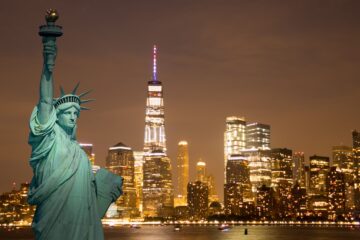Deconstructing Donald Trump’s Wall
By: Zoë Bernard
Donald Trump’s wall is being designed right now. The President smugly promised this last week from a podium in Washington, further solidifying the surreal realities of a new era in American consciousness. Of course, we’ve become all too uncomfortably familiar with Donald Trump’s wall and the unending litany of abuses meted out on American society which it is promised to resolve. Vehemently derided from its inception, the wall often seemed an implausibly dystopian campaign promise — a crowd-pleasing catchphrase so grossly steeped in bigotry and paranoia that it undermined and reframed the notion of American identity itself.
But here it is. Trump’s wall is to be built, a looming emblem of redefined American values that are brazenly at odds with our country’s pro-immigrant foundations. It will be costly, ineffective, and no, Mexico isn’t going to pay for it.
Trump is not the first candidate to announce a border partition, but no other figure has rhapsodised about this separation with such fervent and stirring language. On the campaign trail, Trump emphasized that the wall was not merely a fence. Nor was it a puny “toy wall.” During an NBC interview he pledged, “It will be a new wall, a high wall, a beautiful wall.” We are told that it will be a great, great wall. An inexpensive wall. It will be impenetrable and physical. It will be so tall, so powerful, so huge, and so beautiful as to defy the powers of imagination.
The wall is an identifiable symbol, a forcible construct that immediately resonated with Trump’s supporters, sending up cries of “Build the wall! Build the wall!” at rallies. It was a promise, that like the very thing it represented, was concrete: a solid, definable object, a refreshing reprieve from hazy campaign pledges plagued by inscrutable imagery. It’s not difficult to conjure up a picture of the wall in your mind — you can see it there, a force of cement and cinder blocks, snaking out a charcoal-gray line along the southern border.
On January 22, Trump sent out a self-congratulatory tweet about his meeting with the CIA, writing that many people there “paid great respect to Wall.” The wall is no longer the wall, or a wall, or even Trump’s wall but only Wall. A wall that ought to be paid respects to as though it were an honored individual, or one imagines, an indefatigable godhead. In Trump’s rhetoric, the wall is inalienable and all-powerful; it has achieved a sort of garden-variety animism.
We’re told that the wall will keep out terrorists, deter drug trade, end rape, promote peace, eliminate murder, unify the nation, strengthen the economy, and benefit not only the United States but Mexico. In short, there’s no end of what the wall cannot do to allay our Western anxieties.
It’s this disturbingly persuasive idea of the wall as the ultimate salve to all that troubles the American mind that’s even more powerful than the wall itself. It’s a potent symbol, one that promises to keep all the brown bogeymen of our nightmares at bay. And while Trump and his supporters believe that the building of a wall will symbolize the taking back of American soil or represent the first emboldened brushstroke on the portrait of a country that champions the rights of its citizenry, perhaps it’s time to reconsider this fabricated badge of national virility and splendor.
In an incredibly prescient op-ed from the New York Times in 2011, Costica Bradatan argued that walls are built not for security, but for a sense of security. “What a wall satisfies is not so much a material need as a mental one. Walls protect people not from barbarians, but from anxieties and fears, which can often be more terrible than the worst vandals…what is built is not a wall, but a state of mind.”
Excerpt from “Mending Wall” by Robert Frost. Full Poem here
The building of Trump’s wall represents a restructuring of the American state of mind, a fencing off of American identity. It presents a distorted image of what it means to be an American, the portrait of a jealous and inward-facing nation beset by fear and ensnared by anxiety. Trump’s wall is a veritable advertisement of the country’s private horrors. If built, it’s estimated cost of nearly 22 billion dollars will be one of the most expensive investments of American paranoia ever constructed.
But here’s where Trump is wrong: real walls are not as powerful as the ideas of walls. Unlike the ideas of walls, real walls can be torn down. Real walls can be burrowed under or scaled over or set on fire or bulldozed. They can crumble under the force of time. They can disintegrate and fall. Donald Trump’s wall will only ever be an object, and when stripped of its grandiose rhetoric and severed of its compelling fictions, there it stands: a hideous, thirty-foot tall tribute to fear and insulation. In the future, perhaps we’ll look back on this monstrosity and consider the pitiable legacy of a president and his populace who, instead of building universities or museums or libraries, constructed only an industrialized institution of alarm.












